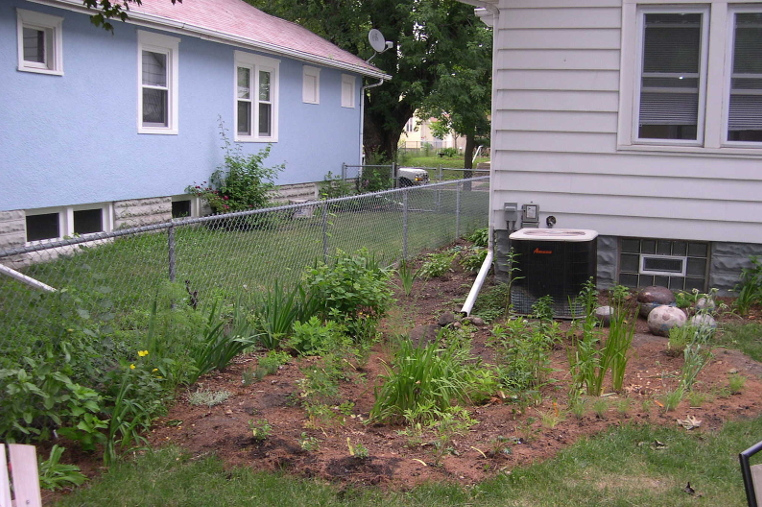When we talk about the economic benefits of gardening, farming, and otherwise fostering a comprehensive local food system, we usually bring up reduced grocery bills, import replacement, and even preparation for national supply chain disruption if our big agriculture model ever proves unsustainable. But we less often talk about the ways that plants—including edible plants—can double as green infrastructure that can take the pressure off the man-made systems we rely on to make our cities function.
Though the term “green infrastructure” wasn’t coined until 1994, the concept is as old as nature itself: rain falls and the natural features of the landscape either absorb it or deflect it. And of course, human beings have been engaging in green infrastructure planning for far longer than we’ve been laying pipes, installing storm drains or otherwise adding “gray” infrastructure to the ground beneath our feet. After all, for centuries, natural solutions were the only way to divert floodwater (think digging trenches and building berms), heat our homes (by encouraging a lumber crop or utilizing geothermal resources), conduct basic sanitation, and meet the rest of our fundamental needs.
Fast forward to the advent of cities and modern-style “gray” infrastructure, though, and the challenges of building and maintaining the systems that keep our places working have multiplied—and so have the costs that come with them. Old American cities like St. Louis, where I live, today have the added obstacle of aging, archaic infrastructure that makes simple problems like basic water treatment even more expensive still. When our infrastructure was first built, St. Louis had a larger population but considerably less asphalt than it does now, and not every building was hooked up to our combined sewage and stormwater infrastructure. Today, though, with vast development (and in particular, parking lots) as far as the eye can see and no trees, soil or other green infrastructure left to absorb the rain, our pipes overflow at so much as the hint of a bad storm. And wastewater from our buildings (read: poop) already in the pipes overflows right along with it.
Combined sewer overflow, explained. (Source: EPA)
The result? 13 billion gallons of sewage-polluted waters dumped into the Mississippi and its tributaries every year, and a staggering water treatment bill to match—not to mention the costly environmental and health-related impacts of this ongoing problem.
Most cities would answer this challenge with every mega-project available to them (and trust me, St. Louis is doing just that—just check out our insanely huge tunnels.) But the infrastructure-saving project I’m most excited about is much smaller—and a lot more beautiful.
In addition to larger structural changes to our major systems, Project Clear St. Louis has been giving out small-scale rainscaping grants directly to residents and business owners for the past four years. Property owners are invited to apply for up to $3,000 each to rip up asphalt, plant native trees, hook up rain barrels and do anything else they can to naturally and cheaply get more rain water down into the soil and keep it out of the sewers.
In the fall, I hope to become one of them. And our plan, if it’s approved, will also feed us pretty well.
A rainscaping project in North St. Louis (Source: Project Clear)
While the Project Clear guidelines don’t require that rainscaping plans include edible food, my partner and I jumped at the chance to merge our love of edible gardening with our desire to have our (currently grassy and boring) backyard contribute to the financial productivity of our region however it can. Our grant stands the best chance of being approved if we plan a rain garden that’s high on perennial native plants with deep root systems to absorb maximum rainwater with minimal maintenance, so we’ve loaded up on sweet plum and paw paw and hazelnut trees, along with currant and gooseberry bushes and a collection of tasty lower-guild plants that thrive in swails, like wild asparagus and edible flowers.
We’re also hoping to rip out the concrete vestiges of an old, unused parking pad, and to put in woodchip paths to our beloved and much-used hammock and what we hope will be our first-ever fire pit that we can cluster around with friends on summer nights. We’re also saving space to grow a few vegetables—while annuals absorb storm water too, perennials and native plants are usually better at the job—as well as an herb spiral to help support my tea addiction.
One of the things I love about the Strong Towns approach is how small incremental projects leave room for the personality and creativity of the person who undertakes them, while maintaining a core commitment to the goal of financial stability. Many of the items on my own rain garden wish list were inspired by my city’s sustainable backyard tour, where citizens all over town invite their neighbors in through the back gate to show off what they’ve done with their land, many of them funded by Project Clear grants.
How often is a major infrastructure projects with demonstrated financial returns also the cause for a city-wide celebration like that? How often are you invited to bike from home to home, chatting with your fellow citizens over lemonades, marveling at how your collective efforts have not just helped take the pressure off your municipal infrastructure, but have grown this gorgeous garden all around you?
I don’t know the math on whether rainscaping projects can outright replace more traditional stormwater management infrastructure; I doubt it. We may need carefully evaluated larger-scale green infrastructure and carefully evaluated gray infrastructure for that. But it makes you wonder: how many unconventional small-scale, incremental, and beautiful solutions to our economic troubles are still waiting for us to discover them? And what will our cities look like when we finally get to work?







